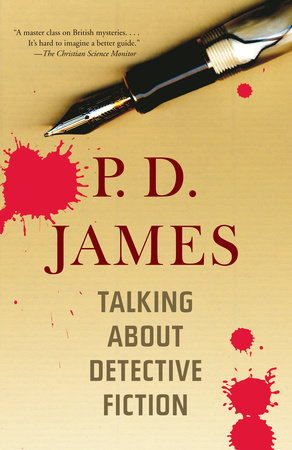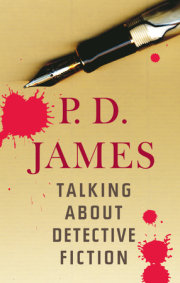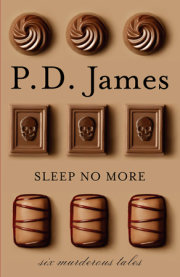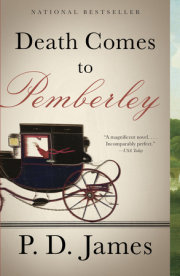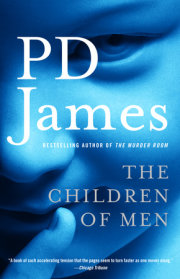ForewardThis book had its beginnings in December 2006, when, at the request of the Bodleian's Publishing Department, the then Librarian invited me to write a book on British detective fiction in aid of the Library. As a native of Oxford I had known from early childhood that the Bodleian Library is one of the oldest and most distinguished in the world, and I replied that I was very happy to accept the invitation but must finish the novel on which I was then working. The book which I was privileged to write now makes its somewhat belated appearance. I was relieved that the subject proposed was one of the few on which I felt competent to pontificate, but I hope that the many references to my own methods of working won't be seen as hubris; they are an attempt to answer some of the questions most frequently asked by my readers and are unlikely to be new to audiences who have heard me speaking about my work over the years—nor, of course, to my fellow crime-writers.
Because of its resilience and popularity, detective fiction has attracted what some may feel is more than its fair share of critical attention, and I have no wish to add to, and less to emulate, the many distinguished studies of the last two centuries. Inevitably there wil be some notable omissions, for which I apologise, but my hope is that this short personal account will interest and enterntain not only my readers, but the many who share our pleasure in a form of popular literature which for over fifty years has fascinated and engaged me as a writer.
Chapter 1: What Are We Talking About and How Did It All Begin?"Death in particular seems to provide the minds of the Anglo-Saxon race with a greater fund of innocent amusement than any other single subject."—Dorothy L. Sayers
These words were written by Dorothy L. Sayers in her preface to a volume entitled
Great Short Stories of Detection, Mystery and Horror, Third Series, published by Gollancz in 1934. She was, of course, talking not of the devastating amalgamation of hatred, violence, tragedy and grief which is real-life murder, but of the ingenious and increasingly popular stories of mystery and detection of which, by that time, she herself was an established and highly regarded writer. And to judge by the worldwide success of Arthur Conan Doyle’s Sherlock Holmes and Agatha Christie’s Poirot, it is not only the Anglo-Saxons who have an appetite for mystery and mayhem. It seems that this vicarious enjoyment in “murder considered as a fine art,” to quote Thomas De Quincey, makes the whole world kin.
In his book
Aspects of the Novel, E. M. Forster writes:
“The king died and then the queen died” is a story. “The king died, and then the queen died of grief” is a plot. . . . “The queen died, no one knew why, until it was discovered that it was through grief at the death of the king.” This is a plot with a mystery in it, a form capable of high development.
To that I would add, “Everyone thought that the queen had died of grief until they discovered the puncture mark in her throat.” That is a murder mystery, and it too is capable of high development.
Novels which enshrine a mystery, often involving a crime, and which provide the satisfaction of an ultimate solution are, of course, common in the canon of English literature, and most would never be thought of in terms of detective fiction. Anthony Trollope, who, like his friend Dickens, was fascinated by the criminal underworld and the exploits of the newly formed detective force, frequently teases us in his novels with a central mystery. Did Lady Eustace steal the family diamonds, and if not, who did? Did Lady Mason forge the codicil to her husband’s will in
Orley Farm, a codicil from which she and her son had benefited for thirty years? Perhaps Trollope gets closest to the conventions of the orthodox detective story in
Phineas Redux, in which the hero is arrested for the murder of his political enemy, Mr. Bonteen, and only escapes conviction on strong circumstantial evidence by the energetic efforts of Madame Max, the woman who loves him and obtains the vital clue which helps to convict the true murderer. Who is the mysterious woman in white in Wilkie Collins’s novel of that name? In Charlotte Brontë’s
Jane Eyre, who is it that Jane hears shrieking in the night, who attacks the mysterious visitor to Thornfield Hall, and what part does the servant Grace Poole play in these dark matters? Charles Dickens provides both mystery and murder in
Bleak House, creating in Inspector Bucket one of literature’s most memorable detectives, while his unfinished novel
The Mystery of Edwin Drood contains enough of the plot to encourage fascinating conjecture about how it was to be resolved.
A modern example of a novel which enshrines a mystery and its solution is John le Carré’s
Tinker, Tailor, Soldier, Spy. This is generally regarded as one of the most distinguished modern novels of espionage, but it is also a perfectly constructed detective story. Here the central mystery is not an act of murder but the identity of the mole at the heart of the British Secret Service. We know the names of the five suspects, and the setting gives us access to a secret esoteric and cloistered world, making us privileged participants in its mysteries. The detective called in to identify the traitor is John le Carré’s sympathetic serial hero George Smiley, with the help of his junior colleague Peter Guillam, and the solution at the end of the novel is one which we the readers should be able to arrive at from evidence fairly presented.
But perhaps the most interesting example of a mainstream novel which is also a detective story is the brilliantly structured
Emma by Jane Austen. Here the secret which is the mainspring of the action is the unrecognised relationships between the limited number of characters. The story is confined to a closed society in a rural setting, which was to become common in detective fiction, and Jane Austen deceives us with cleverly constructed clues (eight immediately come to mind)—some based on action, some on apparently innocuous conversations, some in her authorial voice. At the end, when all becomes plain and the characters are at last united with their right partners, we wonder how we could have been so deceived.
So what exactly are we talking about when we use the words “detective story,” how does it differ from both the mainstream novel and crime fiction, and how did it all begin? Novels which have an atrocious crime at their heart, whose writers set out to explore and interpret the dangerous and violent underworld of crime, its causes, ramifications and effect on both perpetrators and victims, can cover an extraordinarily broad spectrum of imaginative writing extending to some of the highest works of the human imagination. These books may indeed have murder at their heart, but there is frequently no mystery about the perpetrator and therefore no detective and no clues. An example is Graham Greene’s
Brighton Rock. We know from the beginning that Pinkie is a killer and that the unfortunate Hale, desperately walking the streets and lanes of Brighton, knows, as do we, that he is going to be murdered. Our interest is not primarily in the investigation of murder, but in the tragic fate of those involved. The novel adumbrates Greene’s preoccupation with the moral ambiguity of evil, which is at the heart of his creativity; indeed, he came to regret the detective element in
Brighton Rock and his own division of his novels between “entertainments” and those presumably which he intended should be taken seriously. I’m glad that Greene later repudiated this puzzling dichotomy, which picked out certain of his novels for disparagement and which helped to promote the still prevalent habit of dividing novels into those which are popular, exciting and accessible but, perhaps for these reasons, tend to be undervalued, and those in a somewhat ill-defined category which are granted the distinction of being described as literary novels. Greene surely couldn’t have meant that, when writing an “entertainment,” he took less trouble with the literary style, cared less for the truth of characterisation and modified the plot and theme to accommodate what he saw as the popular taste. This is manifestly not true of a writer of whom the words of Robert Browning are particularly appropriate:
Our interest’s on the dangerous edge of things.
The honest thief, the tender murderer,
The superstitious atheist.Although the detective story at its highest can also operate on the dangerous edge of things, it is differentiated both from mainstream fiction and from the generality of crime novels by a highly organised structure and recognised conventions. What we can expect is a central mysterious crime, usually murder; a closed circle of suspects, each with motive, means and opportunity for the crime; a detective, either amateur or professional, who comes in like an avenging deity to solve it; and, by the end of the book, a solution which the reader should be able to arrive at by logical deduction from clues inserted in the novel with deceptive cunning but essential fairness. This is the definition I have usually given when speaking about my work but, although not inaccurate, it now seems unduly restrictive and more appropriate to the so-called Golden Age between the wars than it is today. Not all the villains are among a small group of obvious suspects; the detective may be faced with a single named or secret adversary who must be finally run down and defeated by logical deduction from observed facts and, of course, by the accepted heroic virtues: intelligence, courage and energy. This type of mystery is frequently a highly personal conflict between the hero and his prey, characterised by physicality, ruthlessness and violence, often amounting to torture, and even if the detective element is strong, the book is more appropriately described as a thriller than a detective story. The James Bond novels of Ian Fleming are the obvious example. But for a book to be described as detective fiction there must be a central mystery, and one that by the end of the book is solved satisfactorily and logically, not by good luck or intuition, but by intelligent deduction from clues honestly if deceptively presented.
One of the criticisms of the detective story is that this imposed pattern is mere formula writing, that it binds the novelist in a straitjacket which is inimical to the artistic freedom which is essential to creativity, and that subtlety of characterisation, a setting which comes alive for the reader and even credibility are sacrificed to the dominance of structure and plot. But what I find fascinating is the extraordinary variety of books and writers which this so-called formula has been able to accommodate, and how many authors have found the constraints and conventions of the detective story liberating rather than inhibiting of their creative imagination. To say that one cannot produce a good novel within the discipline of a formal structure is as foolish as to say that no sonnet can be great poetry since a sonnet is restricted to fourteen lines—an octave and a sestet—and a strict rhyming sequence. And detective stories are not the only novels which conform to a recognised convention and structure. All Jane Austen’s novels have a common storyline: an attractive and virtuous young woman surmounts difficulties to achieve marriage to the man of her choice. This is the age-long convention of the romantic novel, but with Jane Austen what we have is Mills & Boon written by a genius.
And why murder? The central mystery of a detective story need not indeed involve a violent death, but murder remains the unique crime and it carries an atavistic weight of repugnance, fascination and fear. Readers are likely to remain more interested in which of Aunt Ellie’s heirs laced her nightly cocoa with arsenic than in who stole her diamond necklace while she was safely holidaying in Bournemouth. Dorothy L. Sayers’s
Gaudy Night doesn’t contain a murder, although there is an attempt at one, and the death at the heart of Frances Fyfield’s
Blood from Stone is a spectacular and mysterious suicide. But, except in those novels of espionage which are primarily concerned with treachery, it remains rare for the central crime in an orthodox mystery to be other than the ultimate crime for which no human reparation can ever be made.
Copyright © 2009 by P. D. James. All rights reserved. No part of this excerpt may be reproduced or reprinted without permission in writing from the publisher.

